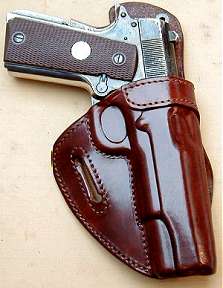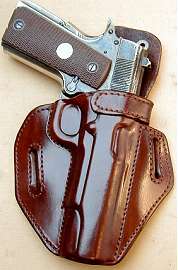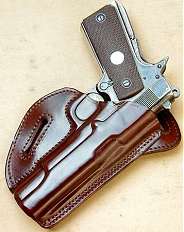"I'm looking for a holster. I'm 6 ft 2 inches tall. I weigh 204 lbs. Which of your models would you recommend?"
Now many may think this to be a pretty dumb question -- and it probably is -- but it's nevertheless the one I get asked more often than any other. A lot of people are under the erroneous impression that by stating their height and weight it's possible, by some magic formula, to conjure up the exact model of holster and mode of carry that will best suit their needs. Nothing could be further from the truth! While these two factors do, indeed, play an important role in holster choice, there are a host of others that come into play, quite impossible for me to envisage, located as I am several thousand miles away. And even if I lived on the person's doorstep, it would still be difficult for me to come up with a definitive answer because there is no way I could take into account that very important element that is virtually impossible to quantify -- an individual's personal preference.
So I decided on this article, which is designed to provide a few simple pointers and guidelines to those of you who are uncertain as to what they should choose in the way of a concealment holster. It won't make you an expert -- at least not straight away -- but it could help to save you quite a bit of money and, additionally, keep you from ending up with a drawer full of holsters collecting dust!
Before investing in a concealment holster for the first time, you need to carefully examine your own particular set of needs, mode of dress, lifestyle and circumstances and decide on the form of carry you wish to adopt. Now there's been much talk of a "universal" holster -- a holster that will do everything for everybody all of the time. I must admit that I do like the idea of such an item and life would certainly be a lot easier for all concerned if one did exist. For a start, it would make holster selection a breeze! Unfortunately, there ain't no such animal! I have examined just about every do-it-all, Jack-of-all-trades, multi-function holster that has cropped up on the market, and I've yet to see one that works efficiently. They tend to do a little bit of everything and not much of anything and, sadly, are not worth wasting money on.
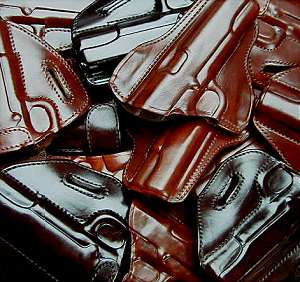
|
Concealment holsters come in a variety of shapes and sizes. All are task-specific to a greater or lesser degree. A small of back holster, for instance, is an outstanding form of carry in the right circumstances, but will not serve you well if you spend most of your time seated in a motor vehicle. Similarly, a strong side IWB carry wouldn't be of much use if you lived in frigid climes and wore several layers of clothing buttoned up to keep out the cold.
You will need, ultimately, to invest in about two, or possibly three, holsters to cover every eventuality. However, it is better to start with just the one – say a normal, strong side, high ride holster with a muzzle rear rake -- then buy the others as and when you feel you need them. A double shoulder holster for two pistols or a small of back holster are possibilities you may want to consider at a later date. As in all things, bring a little common sense and logic into the equation and you won't go far wrong.
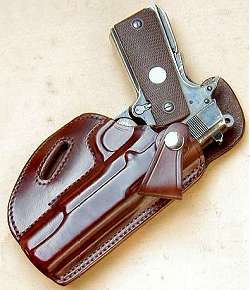
|
Equally important as your choice of holster is your choice of handgun. I don't mean to sound patronising by stating the obvious, nor do I wish to insult or offend anyone, but it is imperative that the weapon you choose be in keeping with your physical characteristics. If, for instance, you are very slight of build but feel the need to carry a large cannon or a wide-bodied weapon, then you are creating a set of problems that aren't going to be solved by anything as simple as a holster!
The same set of difficulties may also be experienced if you have a large waist. Surplus waistline flesh will tend to push out and highlight any appendages on your belt -- such as a sizeable, holstered handgun! Oh yes! I've seen the statements made by some makers who claim that their holsters can cause even the largest of weapons to "disappear!" All I can say is that I've yet to see proof of this phenomenon, but please feel free to check it out!
Fortunately for us, firearm manufacturers have been aware of this problem for some time now and have not been slow in acting positively. The result is a range of slimmer, more compact handguns in most calibers. So it's definitely worth considering an identical load, but in a smaller package, as a possible solution.
Once you've selected your principal weapon, what are the holster options available? The choices may be broken down roughly into three basic categories : strong side directional, weak side crossdraw and small-of-back. Each group will, additionally, encompass several different styles of holster.
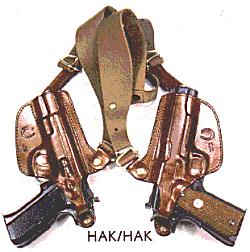 Your strong side holster may therefore be a pancake style belt-slide (Model ML/MLS or Model 30/30S), a full-size wraparound design (Model 28/28S), or even a combination of these two styles (22H/22HS). This applies equally to the crossdraw category (28X/28XS), which will also include shoulder-holsters (HAK or HAK/MM). IWB holsters cover all three groupings as they may be worn strong side, cross-draw or small-of-back for a palm-out draw(as in 62L and 62C series). Additionally, some of these may come fitted with a paddle (PD/PDS) or a spring-clip (62C/62CS). This profusion of styles and models will apply to every single one of the basic options, so there are more than a few choices available.
Your strong side holster may therefore be a pancake style belt-slide (Model ML/MLS or Model 30/30S), a full-size wraparound design (Model 28/28S), or even a combination of these two styles (22H/22HS). This applies equally to the crossdraw category (28X/28XS), which will also include shoulder-holsters (HAK or HAK/MM). IWB holsters cover all three groupings as they may be worn strong side, cross-draw or small-of-back for a palm-out draw(as in 62L and 62C series). Additionally, some of these may come fitted with a paddle (PD/PDS) or a spring-clip (62C/62CS). This profusion of styles and models will apply to every single one of the basic options, so there are more than a few choices available.
Small wonder, then, that asking a hundred different shooters to stipulate their favourite modes of carry will probably get you a hundred different answers! Each will swear by his or her own particular preference. But what suits Jim or Fred or Betty or Ralph is not forced to suit you. Narrowing the choice down to match your own particular set of needs is not always easy, so you shouldn't be discouraged if you don't get it right the first time. Very few people ever do!
The first step is to try out all the basic options. You can start by experimenting with the holsters of colleagues or friends at work or at your regular gun-club. Remember -- it is only by simple hands-on trial-and-error that you can discover the mode of carry best suited to your own physical characteristics and personal needs.
Before proceeding any further, it is important that we consider the subject of Rake. Rake is the angle at which a weapon positioned in a holster is tilted laterally from the vertical. This can be muzzle rear/butt forward, illustrated at left (also known as the FBI tilt) which facilitates a strong side draw, or muzzle forward, illustrated at right, which is ideal for crossdraw. A neutral rake (not illustrated) is where the weapon is vertical and would, in theory, allow it to be used on either side.
With most handguns, the hardest part to conceal is the butt or grip. This is where Rake plays an important part. Tilting the weapon forward from the vertical for a strong side draw will produce a muzzle rear rake which not only facilitates the draw, but aids concealment by absorbing the grip into the band of flesh just above the waist. With either a muzzle forward or neutral rake, however, the grip may have a tendency to protrude, which can compromise successful concealment.
Having decided on a category and style of holster, we now need to select a particular model. The ideal concealment holster should include all the features that allow its wearer to carry a weapon securely and comfortably in a covert and unobtrusive manner, yet allow for instant, trouble-free access when required. In other words, it needs to have incorporated into its construction the five essentials of security, safety, comfort, speed and concealability.
I have tried – successfully, I think -- to build these five elements into all of my holsters. Contouring them, wherever possible, and providing wide-spaced slots or tunnel loops allow them to be drawn close into the body for optimum concealment. This also allows for positioning over a trouser belt-loop for weight-distribution and stability.
Additionally, weapon retention, security and speed are catered for by blocking and hand-molding each holster to the exact contours of the handgun it is designed to carry. This eliminates the need for safety straps or thumb breaks. Sight rails or a sight channel also help in providing a snag-free draw.
For comfort, all of my holsters (except the model SOB2, where it is unnecessary) come with the option of a rear protective tab. This can prove invaluable in protecting both you and your clothing from chafing and discomfort from your weapon over extended periods of use.
With task-specific holsters, however, the essential elements will vary to a greater or lesser degree from model to model. Because of the specialised use, some of the elements must be sacrificed or diminished and a compromise reached in each case. A paddle holster, for instance, will lose a certain amount of concealabilty and speed in the trade-off for ease of on-off use. Ditto for a crossdraw holster. Here not only concealability but security is impaired, because the weak side butt-forward configuration offers a full firing grip of your weapon to any adversary in the course of a struggle.
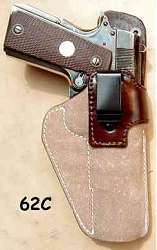
|

|
Inside-Waistband (IWB) holsters, because they sacrifice comfort for concealability, can also be a boon or a bust. Some users swear by them, others at them! The short answer is that you either get on with them or you don't, and the only way to find out is by trial and error i.e unloading your weapon and shoving it down your waistband. However, a word of caution for the use of this form of carry with the wide-bodied Glocks or Sigmas. It may be OK for short term use but can be excruciatingly uncomfortable over extended periods – especially if you have a wide magazine in an IWB carrier as well!

|

|
The pancake-style belt slide holsters such as the ML/MLS or the 30/30S should also be avoided for the Glocks and Sigmas. These work perfectly while the weapon is holstered, but may close up on themselves once it is drawn, thus making tactical re-holstering (one-handed re-holstering in plainspeak) a problem. Ideally, a holster with a reinforced mouth such as the 28/28S or the 22H/22HS should be selected for this type of weapon.
I must apologise to any potential customers looking for pocket or ankle holsters. These are strictly task-specific and I know that most other manufacturers make them -- and so would I, given the resources. However, one of the penalties of running a small enterprise is that it's impossible to be all things to all people, so I concentrate on increasing the quality and availability of my product line, rather than its range. On the plus side, I do have a bigger selection of other types of concealment holsters and options on offer than practically any other holster maker, big or small -- and that's not bad for a one-man operation!
I am often asked which model of holster I personally consider to be the best -- one that I would recommend above all the others. Well, the honest answer is that there really isn't one. Every one of my holsters is designed for a specific application and performs admirably within the parameters of that application. Many are very strictly task-specific, so any sort of general comparison would be quite inappropriate. It's strictly a case of "horses for courses!" If I were really pressed -- and I mean arm-around-the-neck, knife-at-the-throat pressed -- then I would have to go for my model 22H. This holster has the slim profile of a pancake belt slide, but with a reinforced mouth -- plus just about every other feature you could possibly think of or want. It is the one design I am most proud of and it is truly the Aston Martin of my collection!
I have tried to be as objective as possible in providing these very general guidelines. If I've forgotten anything, please let me know by email and I'll try to include an answer immediately. I take this opportunity to thank you for taking the time to browse through my online catalog and I hope I've been of some assistance in helping you to decide which model of holster will best suit your needs.


 Your strong side holster may therefore be a pancake style belt-slide (Model ML/MLS or Model 30/30S), a full-size wraparound design (Model 28/28S), or even a combination of these two styles (22H/22HS). This applies equally to the crossdraw category (28X/28XS), which will also include shoulder-holsters (HAK or HAK/MM). IWB holsters cover all three groupings as they may be worn strong side, cross-draw or small-of-back for a palm-out draw(as in 62L and 62C series). Additionally, some of these may come fitted with a paddle (PD/PDS) or a spring-clip (62C/62CS). This profusion of styles and models will apply to every single one of the basic options, so there are more than a few choices available.
Your strong side holster may therefore be a pancake style belt-slide (Model ML/MLS or Model 30/30S), a full-size wraparound design (Model 28/28S), or even a combination of these two styles (22H/22HS). This applies equally to the crossdraw category (28X/28XS), which will also include shoulder-holsters (HAK or HAK/MM). IWB holsters cover all three groupings as they may be worn strong side, cross-draw or small-of-back for a palm-out draw(as in 62L and 62C series). Additionally, some of these may come fitted with a paddle (PD/PDS) or a spring-clip (62C/62CS). This profusion of styles and models will apply to every single one of the basic options, so there are more than a few choices available.
